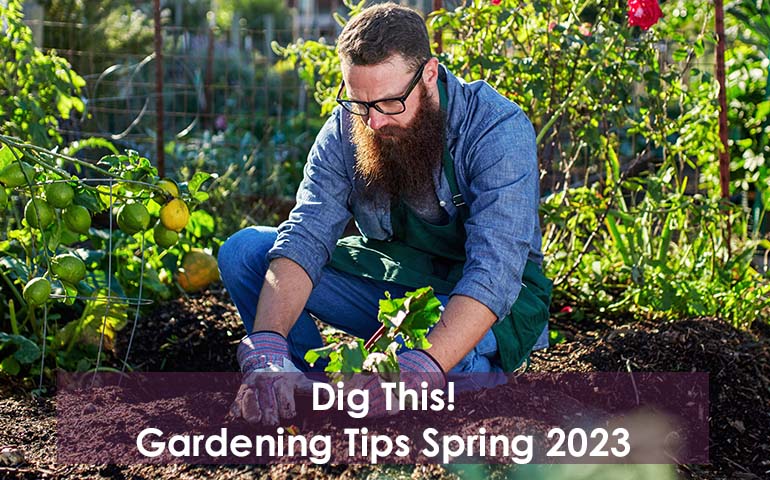
Dig This! Gardening Tips Spring 2023
by Chris Petry
Confession: I do NOT have a green thumb. I did at one time. Or perhaps it was the kind
of pure dumb luck only an 8-year-old could muster that allowed me to grow a 40lb pumpkin one
summer. Problem is, I never matched my efforts and I’m willing to bet there are a number of
you reading this right now that fall squarely in my camp. Or worse, you scouted out the perfect
place to plant a finicky flower, life got in the way, and you only remembered you had a finicky
flower when you discovered its lifeless corpse 3 months later.
Unfortunately, there’s no magical elixir that will turn you into a prize-winning horticulturalist
overnight. There is, however, this thing called Google. I spent days looking up tips and tricks for
cultivating everything from potatoes to Icelandic Poppies. You know what I discovered in that
time? Gardening is a science. Pure and simple. While I consider myself something of a scientist
once the food makes its way to my kitchen, meaning I know what to do with it to prepare
delicious meals, I never considered all the variables involved in getting it to that point.
Whatever you’re attempting to plant, make sure it’s the right season for it. Tomatoes for
instance, are more likely to ripen if the temperature is above 60 but below 80. When planting
perennials, make sure the hole is twice as wide as the bulb to help roots take hold. Dead leaves
spread across your yard may add a certain Gothic ambience to your lawn but they’re not so
great for emergent strains of grass. Fortunately, if you chop em’ up for your composting you can
gain incredible benefit from them.
A cactus is going to need much less water than a watermelon. Pansies love the cold but
sunflowers, hard as it is to believe with a name like ‘sunflower’, need sun. Everything needs
good soil. If the soil’s too wet, too dry, acidic, or has poor drainage you’ll have poor results.
Again, most of this info can be found rather easily with a quick Google or on the Better Homes &
Gardens website (BHG.com).
So, you’ve mastered the science of gardening. Or more accurately you managed to keep
something alive for 3 or 4 days. What next? Well, now it’s time to head over to Instagram, look
at other people’s gardens, and weep because yours will never look like a Renoir painting. Or you could “borrow” some of their ideas and put your neighbors to shame. Trends this year seem to be pointing toward a more minimalistic approach. A smaller inventory of plants that are better
maintained. A focus on species that are native to your region instead of importing more exotic
crops that are less likely to survive yo-yoing weather patterns.
Eco-friendly and renewable is all the rage. Turn your garden into a showstopper after dark by
taking advantage of our most abundant renewable energy source, that big glowing ball of
plasma we call the sun. Solar lights are in. Tasteful path lights and lanterns, the odd butterfly or
frog, mini-Edison bulbs and even paver stones or pebbles. Solar lights make use of photovoltaic
cells (or PVs). These cells absorb solar energy during the daytime and convert it into electricity,
illuminating the bulb or reflective surface at night.
Finally, the #1 trend in Gardening this year, and perhaps for the foreseeable future, is online training and webinars with successful gardeners. The popularization of teleconference technology over the last couple years has resulted in more channels and resources than ever for interacting with and/or learning from the real pros. Check out some of the links below to see if there’s a webinar that works best for your interests and schedule. Most are free and even the
Smithsonian is participating! Get your guidance from an expert not some random guy who grew a freakishly huge pumpkin in 1997.
Smithsonian Webinar
Fine Gardening Webinar
National Garden Bureau Webinar
Phipps Conservatory Webinar
Nature Conservancy Webinar





